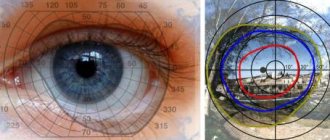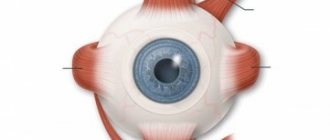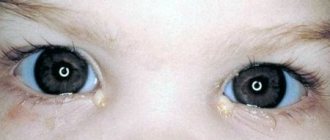Children with vision problems are significantly different from their peers; they require more attention and a different approach to learning various skills than their peers with good vision. As a rule, they have more developed other sensory organs, with the help of which they perceive the world. Compensation occurs due to excellent hearing and touch. Knowledge acquisition and teaching methods vary and depend on the individual degree of visual impairment.
The visual organs play an important role both in the way of one’s own perception and its development, and in the idea of the space around. All movements that a person makes are controlled by vision. For a child, this is the most important aspect, since his learning and orientation in the environment completely depends on visual acuity. Mastery of the alphabet, numbers, and the ability to navigate by certain signs and symbols help to adapt from early childhood, first in kindergarten, then at school and further in life. There is such a thing as typhlopedagogy, which helps children with poor vision learn and receive a full-fledged education on an equal basis with their peers. A child should not feel inferior just because he lacks sharp vision.
Types of childhood vision disorders
Children's visual impairments are functional and organic in nature.
You can fight the first changes either on your own or with the help of specialists. They can be corrected and treated, up to complete cure. Such disorders include:
- Myopia or myopia. This is a very common disease in which a child, due to insufficient refractive power in the visual organs, is unable to clearly see distant objects, for example, what is written on a blackboard. Their behavior and habits differ from healthy children in that they squint, trying to see objects, tilt their heads strongly and bring a textbook or book closer to their eyes.
- Farsightedness or hypermetropia. here Here, on the contrary, the opposite effect is observed when, after the refraction of the rays, the focus appears further than the retina. Such patients do not see close objects, and their vision is focused on the distance. Very often, when the eyes are strained, a child with farsightedness experiences headaches, heaviness and pain in the eyes, severe and frequent fatigue from having to strain to see the text of a book or a nearby object.
- Strabismus. This disease is characterized by a deviated point of fixation of one of the eyes. In children with a similar disease, the acuity of perception of the eye with the pathology decreases, and the susceptibility of both eyes is generally impaired. The ability to see the image as a whole becomes impossible. The causes of this disease can be heredity, mental trauma in the form of fright, infectious diseases, eye abnormalities and many others. Signs usually begin to appear as early as two years of age.
- Astigmatism in children is a very common disease . A similar change occurs due to injury, surgery, or diseases of the cornea. There are three main types: simple, complex and mixed astigmatism.
- Nystagmus or eye tremors. With this disease, spontaneous fluctuations of the eyeballs are observed. It happens that the eyes rotate horizontally, vertically, or in a circle. This disease is difficult to treat and is considered complex, since the causes lie in lesions of the pituitary gland, cerebellum or medulla oblongata. With nystagmus, children have poor vision and see objects blurry.
Read how to treat strabismus in children here.
Organic visual impairments are caused by morphological changes in the structures of various parts, such as the visual pathways, nerves or blood vessels. Most often, such disorders are associated with concomitant defects or lesions. Here you can list various congenital defects of the nervous system, cerebral palsy, mental retardation or hearing loss.
Congenital
Visual impairment received at birth indicates damaging factors that acted during the intrauterine development of the fetus, such as infectious lesions or metabolic disorders. Of course, those who are unlucky enough to be born with a defect experience negative attitudes from their peers from an early age. To prevent this from happening, it is necessary to explain to children from infancy, for example, who colorblind people are and how to treat them. Colorblindness should not be the reason for a terrible attitude.
Hereditary damage transmitted through the family tree. Here the most common are cataracts, glaucoma or color blindness.
Purchased
Such disorders occur after the child is born, and the causes are infections, injuries to the visual organs, and serious illnesses.
All types of violations can have any nature of occurrence. For example, myopia is often both congenital and acquired; this largely depends on the signs of the disease. The same is true for other types of low vision.
Psychological characteristics of children with visual impairments
In the formation of the psyche of children with visual impairments, it is necessary to proceed from the capabilities and needs of children, taking into account their characteristics associated with visual impairment. The characteristics of children that distinguish them from their peers with normal vision appear already at the first meeting.
- not very well coordinated, insufficiently focused, uncertain movements (insufficient range of movements)
- eye contact, communication with gestures - limited or almost absent
- Speech contact is better organized, but children three to four years old in most cases have delayed speech development. In older children, there are often signs of speech disinhibition and verbalism (the child may talk a lot about abstract things, and not be able to answer a specific question about the world around him, or compose a simple story from a picture).
- in tests for dynamic praxis and reciprocal coordination, most children experience significant difficulties. Finger tests perform better.
The examination procedure may take 1.5-2 times longer due to the fact that a visually impaired child needs to be given more time to complete the task due to difficulties in perception and slow processing of information, as well as due to difficulties in organizing the child’s activities, inaccuracy of movements, etc. They are characterized by great uncertainty about the correctness and quality of work, which is expressed in more frequent requests for help in assessing activities from an adult, translating the assessment into a verbal communication plan.
Many children need additional stimulation to maintain attention and encouragement to complete a task due to the child's uncertainty, stiffness and indecisiveness.
Visually impaired children differ greatly from each other in their state of vision, performance, fatigue and speed of assimilation of material. This is largely due to the nature of the visual impairment, the origin of the defect and the personal characteristics of the children. Children in the same age group, having approximately the same visual diagnoses, can differ greatly in their level of intellectual development and psychoneurological status.
Violations in the emotional-volitional and communication spheres - as a rule, children with visual impairments are characterized by increased emotional vulnerability, resentment, conflict, tension, and inability to understand the emotional state of a communication partner and adequate self-expression.
The games of such children are characterized by less development than the games of ordinary children; they require the organizing help of an adult to a greater extent, at first throughout the game. The rules of the game have to be repeated many times, and although children’s actions are, as a rule, stereotypical, fragmented perception prevents them from maintaining a holistic image of the game plot. Difficulties in mastering objective actions lead to the fact that many children, even of older preschool age, remain at the level of objective-practical activity in their spontaneous behavior.
Visual impairment is also associated with difficulties in motor development: the lack of stereoscopic perception, the monocular nature of vision in children with amblyopia and strabismus reduces the motor activity of children.
Having less mobility and little experience of communication, they are poorly oriented in the elements of expressive movements of the body and poorly use gross motor skills to express their feelings and desires, thereby not creating for themselves a system of motor images that reflect the attitude towards objects and subjects of communication, and do not have clear images expressing your feelings in pantomime. As a result, there is a misunderstanding of the language of pantomime among others and difficulties in one’s own communications.
In addition, children with visual impairments, especially when communicating at a distance, are characterized by inaccurate perception of gestures due to decreased acuity of central vision and impaired binocularity. They use gestures less often and only, as a rule, to clarify verbal information, which is due to the immaturity of non-verbal communication means. Noteworthy is the fact that it is very difficult for such children to hear another child, their speech is usually monologue, and they have very little interest in what their play partners say. On the one hand, this may be due to a lack of perception; on the other hand, it may be due to the influence of protective upbringing in the family.
The behavior of children with visual impairments in most cases lacks flexibility and spontaneity, and non-verbal forms of communication are absent or poorly developed. They are characterized by stereotypies - the inert attachment of a word to the image of one specific object or phenomenon inhibits the activity of the imagination, prevents the use of words and concepts in non-standard situations, combining and creating new images.
As a result, the content of the stories invented by children contains few of their own plots. They mainly feature paintings and excerpts from famous fairy tales and stories. But they also suffer from stereotyping, low variability, and lack of integrity; emotionality, originality and completeness of the narratives are poorly demonstrated.
The study of the creativity of children with visual impairments shows the influence of visual impairment on the pace of development of creative creative play and requires a special correction, a training stage aimed at firmly mastering the methods of play action, expressing their emotions, which in the future allows children to show and develop their creative potential.
Of course, the general somatic weakness of children attending a correctional preschool institution also matters. An increasing number of children entering kindergarten, in addition to eye diseases, have concomitant disorders of the central nervous system, musculoskeletal system, and other organs. If we add to this circumstance the fact that a child with impaired vision has to work much harder to receive and process the ever-increasing flow of information that surrounds him today from all sides, it becomes clear that such stress cannot but affect the child’s fragile psyche . As a result, the insufficient formation of voluntary mental processes and the emergence of a passive position in relation to the environment, which causes negative emotions in him, slows down and complicates the process of developing self-regulation.
In order to find out the degree and level of ability for self-regulation, it is necessary first of all to find out the child’s knowledge of himself, the presentation of his external image, knowledge of the capabilities of his senses, which are formed on the basis of his own tests, checks of his physical qualities, motor abilities and understanding of what he like or dislike what he can or cannot do.
Specificity compared to the norm is in most cases quantitative - those with normal vision have more and more complete verbal descriptions, although they also do not use specific designations of color and shape.
Almost all children with amblyopia and strabismus do not talk about the sense of touch as a means of understanding the world around them, but highlight the function of the hand as support when falling, i.e. assistance to vision, which characterizes difficulties in movement and orientation in space, while those with normal vision highlight the tactile function of the hand in communication and in the knowledge of surrounding objects. This indicates that, despite the shortcomings of visual perception, children with amblyopia and strabismus rely mainly on it, weakly using touch, hearing, taste, smell, etc.
Ready for school
By the age of 7, the child experiences difficulties in perception due to a change in the leading activity from play to learning: he “begins to withdraw and becomes uncontrollable.”
Diagnosis of readiness for learning at school is carried out in preparatory groups annually in April-May. The survey results show that children attending correctional kindergarten are generally well prepared for school; from 40 to 60 percent of children have high scores in this test.
The technique includes the following tests:
- "Find the rule." Demonstrates the ability to find a pattern.
- "Checking in the house." Reveals the level of development of logical combinatorial thinking.
- "Schematic recording of words under dictation." Reveals the level of development of phonemic hearing.
- "Meaningless syllables." Determines the development of fine motor skills of the hand.
- "Attention. Orientation. Quantity" Reveals the level of development of attention, the ability to orient in space, and the formation of the idea of quantity.
- “Invitation to visit” - determines the level of development of visual-schematic thinking, the ability to use the rule.
Most often, children cope better with tasks on logical thinking and phonemic awareness, and they also do well with writing nonsense syllables and with orientation tasks. Difficulties often arise when performing the “Moving a House” test (for combinatorial skills) and in the task of determining quantities, especially the more-less ratio.
The number of children with a low level of school readiness is usually from 10 to 20 percent of the total number of kindergarten graduates.
The 7-year-old crisis, which occurs in children with normal vision, is characterized by three main symptoms:
- loss of spontaneity,
- mannerisms,
- "bittersweet" symptom.
This age period is associated with the transition to a new leading activity for children - learning. A change in leading activity presents the child with new demands that he must accept while performing the functions of a student. However, understanding and accepting the need for new requirements does not mean that they entail their mandatory implementation.
If in preschool age knowledge about one’s visual characteristics has not yet caused deep negative emotions, then the end of primary school age and the transition to middle school is associated with a crisis of self-esteem. Negative emotions that arise as a result of revaluation of values begin to predominate in children. There is a change in the child’s internal position, attitude towards learning, his motivation, attitude towards peers and the teacher.
If in the first years of schooling the teacher’s opinion was not only taken on faith, but also his demands were considered indisputable, then by the end of primary school age educational activity loses its leading importance, and the attitude towards the teacher is subject to a strict reassessment. The teacher becomes not only a bearer of knowledge, but the child cares about his attitude towards the students and their problems in life.
Criteria by which children with emotional disturbances are identified among the blind and visually impaired (it is enough that the child meets at least one of the criteria):
- learning disability that cannot be explained by the child's intellectual, sensory or health factors;
- inability to successfully manage interpersonal relationships with students and teachers;
- inadequate type of behavior and well-being under normal conditions or circumstances;
- a prevailing general mood of depression or feeling unhappy;
- a tendency to develop physical symptoms of fear related to school personnel or school problems.
An important place belongs to the adult, who is included in the game as an equal partner. The learning elements included in the game prepare children to transition and master learning activities. Along with gaming methods, it is also necessary to use an art therapeutic approach that promotes the formation of a holistic and positive understanding of the world around us.
Of great importance is the attitude of parents towards the child’s defect and the resulting various systems of relationships in the family. Overestimation of visual impairment leads to excessive care and contributes to the development of an egoistic personality with a predominance of passive consumer orientation and negative moral qualities. Underestimation of a defect leads to unjustified optimism and indifference, frivolity and loss of sense of duty.
Parents of a visually impaired child often tend to overly pity and protect him, rush to satisfy any desires and whims, thereby fostering selfishness and dependent tendencies in him.
In early childhood, the child is not subjectively aware of the system of demands placed on himself, but gradually, towards the end of the preschool period, he begins to act according to the adult program, i.e. it also becomes his program. Thus, the demands put forward by the teacher become the child’s demands on himself.
In modern society, a large number of systems for correction and compensation of visual defects using medical, psychological and pedagogical means have been developed, which have shown the ability of children with visual impairments to achieve a high level of mental development, overcoming the negative impact of visual defects on both the formation of the sensory, intellectual and emotional spheres of the individual.
Features of development
It is known that thanks to the eyes and acute vision, a person is able to receive up to 90 percent of all information about the world around him. When this important organ falls out of the complex of perceptive systems, those that are capable of replacing sharp eyes are included in the work with particular acuity, these are hearing and touch. Smells and sounds for a visually impaired person become the main guides and assistants in the world. The formation of the environment begins, snakes and noses work, the world begins to acquire its own appearance and meaning.
Due to decreased vision, the child begins to limit his scope, and the world is known in a smaller volume. This can negatively affect the development of many skills such as speech, memory and attention. In a blind child, the connection between words and objects in reality is disrupted.
However, for visually impaired children, vital and physical activity, in the form of outdoor activities, games or entertainment, plays a huge role. This allows you to develop coordination to the required level, thanks to which the child will be able to navigate well in the space around him. The feeling of muscle strength, tone, stimulates movement, and also helps improve vision. But, you should not be too overzealous with physical activity, since an overdose in this sense can also negatively affect the condition of the little person.
When learning life skills and any specific actions, it is very important that the child has a “faithful hand” nearby. An action or movement must become automatic; this is achieved through repeated repetition.
The selection of toys for children with low vision is also of particular importance . Items should be bright, large in size and have a textured surface. This helps simulate the development of tactile senses and residual vision. Musical or noise toys will be especially attractive and interesting; they will allow the child to remember the object and create a certain image.
If there is a child in the family with a visual impairment, you should not limit him in communication; close family contacts and connections will only help him, morally and psychologically, not to become a hermit, not to feel like an outcast.
Brief characteristics of students with visual impairments.
Blind children are children with a complete absence of visual sensations or
preserved light perception, or residual vision (0.04 with glasses).
Blindness is bilateral incurable vision loss. Most blind children have some vestiges of vision (they can count the fingers near their face, distinguish the contours and color of an object in front of their eyes, and have light perception). The earlier the defect occurred, the more noticeable the developmental deviations are. Blind children are divided into those born blind and blind.
People born blind have a lag in the development of imaginative thinking and difficulties in movement. Attention, logical thinking, speech, memory develop normally. It is with great difficulty that the correct relationship between abstract knowledge and concrete ideas is formed. They learn abstract concepts more easily than concrete ones. There are disturbances associated with difficulties in learning, playing, everyday life, uncertainty, passivity, a tendency to self-isolate or irritation, excitability, aggressiveness. In blind children, vision is lost after birth - in preschool or school age. The preservation of visual representations is important: the later a child loses his sight, the greater the volume of visual representations he has, which can be recreated through verbal descriptions. If you do not develop visual memory, a gradual erasure of visual images occurs. The normal mental activity of blind children relies on auditory, motor, skin and other analyzers. On their basis, voluntary attention, thinking, speech, recreating imagination, and logical memory develop, which are leading in the process of compensation. Corrective-compensatory education for the blind allows them to receive a complete secondary education and a manufacturing specialty (for example, radio and electrical engineering) in 11 years. The concept of “blind” includes two categories of children with an “O” visa and light perception, as well as those with a residual visual acuity of up to 0.05 on the better seeing eye with correction; such children are taught on the basis of the Braille system, using textbooks intended for perception through touch.
2. Visually impaired children.
They are characterized by visual acuity with glasses from 0.05 to 0.2.
Even with this impairment, vision remains the primary means of perception. The visual analyzer is the leader in the educational process; other analyzers do not replace it, as in the case of the blind. The overview of the surrounding reality is narrowed, slow and inaccurate, so visually impaired children are characterized by limited and distorted ideas; the processes of memorization and mental operations are slowed down, orientation in space is difficult. Many visually impaired people have impaired color perception. Irritability, isolation, and negativism associated with failures are also characteristic. When studying in a public school, visually impaired children experience a number of difficulties: difficulties in recognizing the characteristic external signs of objects due to the vagueness and slowness of perception; difficulties in distinguishing lines that are similar in the writing of letters and numbers, leading to the inability to master counting and reading. In a regular school, visually impaired children do not see what is written on the board or pictures on tables. When working visually, such children quickly get tired, which contributes to a further decrease in vision, as well as a decrease in mental and physical performance. When teaching at school for the visually impaired, special optical aids are used: telescopic glasses, contact lenses, magnifiers, projectors, increased illumination, textbooks with large print. A study of residual - both achromatic and color - vision in the blind, conducted by A. I. Kaplan (1979), showed that residual vision cannot be considered only as an extreme degree of weakening of normal vision. It has other characteristics depending on various clinical forms. Residual vision is a certain integral property of a deeply damaged visual system, the peculiarity of which is the unevenness of the insufficiency of various visual functions, the lability and instability of individual components and the visual process as a whole, and the tendency to the onset of rapid fatigue. The author has identified three forms of residual vision with visual acuity of 0.04 and lower, depending on the complexity of visual impairment.
1. The first is characterized by the highest functionality. With this form, there is a slightly narrowed field of vision, trichromatic color discrimination with reduced color sensitivity.
2. The second is characterized by the presence of peripheral scotomas (“blind” areas of the retina), a narrowed field of vision, pathology of color discrimination with low criterion coefficients of light sensitivity, brightness and stability.
3. In the third form of residual vision, there is a sharp concentric narrowing of the visual field, central scotoma or multiple local defects in the visual field, widespread pathology of color discrimination with a disproportionate decrease in criterion coefficients. In the presence of these disorders, children can only isolate objects from the surrounding background, without identifying the chromatic elements that make them up.
The number of complex, complex visual diseases in children has increased. Only
Some children have a single visual impairment. Analysis materials
visual conditions of blind school children show that the majority of students have
two or three different eye diseases.
The close relationship that exists between central nervous system disorders and fetal eye development in early pregnancy may indicate common causes of brain disorders and eye diseases. Cases are often observed when the main primary changes in the visual system are accompanied by secondary glaucoma, retinal degeneration, microcornia, and are combined with disorders of the central nervous system.
Causes of visual defects. The causes of blindness can be congenital: toxoplasmosis during embryonic development, other infectious diseases of the mother during pregnancy, metabolic disorders, inflammatory diseases. Some types of blindness can be inherited. The following congenital vision defects are also known: microphthalmos - gross structural changes in the eye, anophthalmos - congenital eyelessness, cataracts - clouding of the lens.) Other diseases are: retinal pigmentary dystrophy, astigmatism (anomaly of the refractive power of the eye), congenital brain tumors. Acquired visual anomalies are less common than congenital ones. Hemorrhages, injuries, acquired cataracts, glaucoma (increased intraocular pressure), and optic nerve atrophy can lead to visual impairment. The cause can also be meningitis, meningoencephalitis, complications of influenza, measles, scarlet fever, brain tumor, myopia. The main form of visual defects is damage to the pathways and visual zone of the cerebral cortex, as well as the lens. Congenital cataracts are caused by hereditary metabolic diseases, intrauterine infections
Psychological development of children
The development of a blind or visually impaired child is much different from the full development of normal children. It should be remembered that there are patterns that cannot be changed for known reasons. Three provisions regarding a preschooler that need to be taken into account and approached especially:
- There is retardation in development, both physical and mental. This is due to the limitation of activity and the inability to be on time everywhere and everywhere, as children have acute vision.
- Certain periods and stages of development of a blind child cannot occur at the same time as others. There must be some compensation for other senses, and until replacement or compensation occurs, retardation will continue to be observed.
- In the life of a blind child, there is some disproportion in the development of personal aspects, this concerns speech, thinking, and movement.
- There are also problems with coordination of movements, impulsiveness and abruptness of movements are typical for blind children, since the skill of walking is also acquired much later.
Prevention
From the very first period of a child's birth, it is worth making a visit to an eye doctor to determine visual acuity. Already at the age of 1 month, the mother should show the child to an ophthalmologist.
Eye exercises for farsightedness can be found here.
After a diagnostic examination, possible congenital problems are identified. Recommendations for preventive actions from a very early age if pathologies are identified are very important. Early diagnosis is an opportunity to avoid many problems in the future, especially during the school period.
If the violations are quite serious, the doctor suggests that parents consider visiting specialized child care institutions to educate the child. There are special kindergartens and boarding schools where blind or visually impaired children can study with the help of special aids and adaptation equipment.
What is blurred vision, read this link.
Useful literature for parents
If the child does not have significant deviations from the norm, and changes for the better are possible, then parents should make sure that he follows the following rules:
- Do not read while lying down, take the necessary breaks to rest your eyes for 2-3 minutes.
- Do special exercises for the eyes.
- Do not sit in front of a TV or monitor for a long time.
- Spend more time outdoors and exercise.
- There are vitamins in the form of fresh vegetables and fruits.
Read more about which children's vitamins for the eyes are best in the article.
Stye on the eye: causes and treatment
Retinal dystrophy, in particular peripheral, is described in this article.
What is eye keratitis https://eyesdocs.ru/zabolevaniya/keratit/vospalenie-rogovicy-glaza-opredelenie-i-lechenie.html










